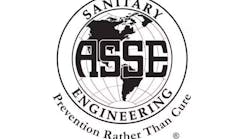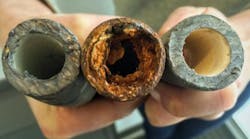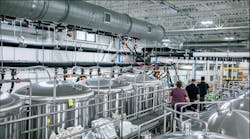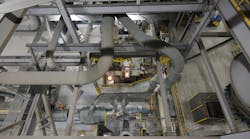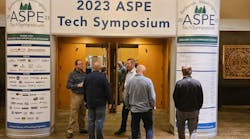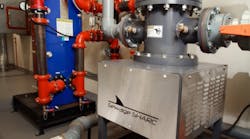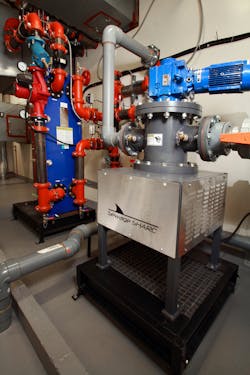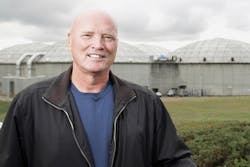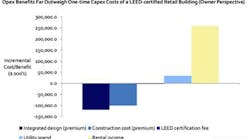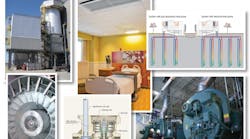We, as people, have a short-but-sweet relationship with energy. Hot water comes from our showers and sinks, is quickly heated up, and brought into our lives at a moment’s notice. However, just as quickly, that water is back down the drain.
While this may not seem like such a big deal, the numbers add up quickly when put on the scale of entire buildings. In fact, Lawrence Livermore National Liboratory says the United States wastes 61 percent of its energy, much of it circling the drain in bathrooms and kitchens. The U.S. Department of Energy, meanwhile, says 400 billion KW of hot water is wasted each year, which is about $40 billion worth.
Lynn Mueller, president and founder of International Wastewater Systems (IWS), based in Port Coquitlam, BC, Canada, wanted to find a way to make use of energy that usually ends up wasted. He and a team of technical and engineering professionals founded IWS with the intent to save heating and cooling resources, as well as help improve the environment.
“What we do is recover all the heat that goes down the drain,” Mueller said. “Residential uses, like showers, laundry, and dishwashers—every day, all the heat goes down the drain. We have developed a system that will take raw sewage, clean it up, recover the heat, and reuse it. … I’m trying to make these buildings have a little longer relationship with heating and hot water, for sure.”
How It Works
IWS’ Sewage SHARC (which stands for sewage heat recovery) uses raw sewage as a medium to produce hot water, heat, and cooling for large residential and commercial buildings. The sewage is used before it gets to the plant, with all of the solids removed. It is put through a heat exchanger and utilized to produce 140°F water for domestic potable use.
Mueller said this process is 500 percent efficient; every dollar spent gets $5 worth of efficiency. The SHARC system will last for about 30 to 40 years, thereby becoming extremely valuable over its lifespan. In fact, he said buildings can recover the money spent on the systems in three to 10 years.
In addition to the SHARC, IWS also offers a retrofit version of the technology known as the PIRANHA. While the SHARC is custom-built or constructed with new buildings, Mueller said the PIRANHA is a prepackaged unit that comes in 50-kw-per-hour and 100-kw-per-hour models. This version can easily be put into a building’s mechanical room and have the sewer line looped into it. Mueller said it was originally produced to help the European market improve its energy footprint by 25 percent, something it legally must do with each update of a building.
With his background in geothermal-heat-pump technology, Mueller said he figured out that it was possible to use sewage as a source of energy instead of using holes in the ground. So far, the response has been phenomenal, Mueller said. IWS has been in business for five years and marketing the SHARC product for two. In the last two years, IWS has made installations across three continents—Australia, Europe, and North America—and says it is working on 30 to 40 jobs around the world right now.
SHARCs Keep Moving
One SHARC success story comes from Richmond, Vancouver, B.C., Canada, at the Gateway Theater, a 50,000-sq-ft public facility. The city had a carbon-reduction plan in place and needed to reduce the facility’s emissions by 50 tons a year and decided to use the SHARC to become the first wastewater recovery system at a public facility in Canada.
Levi Higgs, the city’s corporate energy manager, told HPAC Engineering that before adopting the SHARC, the city undertook a couple of studies and found there was a large amount of potential for a heat- recovery system at the Gateway. This was attributed to the large pumping system next to the theater. Mueller made a proposal that Higgs called “very cost competitive,” and the city has seen some great savings since the installation in April 2013.
“Right off the bat, we saw about a 30 percent reduction in our natural- gas use with the SHARC system,” Higgs said. “We did some upgrades at the facility … and those coupled with the SHARC, we were able to push savings to about 45 percent.”Higgs said the SHARC works so well for the Gateway Theater because of the proximity of the pumps to where the displaced heat is going. Other situations may not be able to make the best use of the SHARC because of distance, but he said it has been fitting in very well in Richmond thus far.
In a YouTube video tour of the installation, Richmond Facility Operations Manager Phil Hogg said Mueller researched systems across the world before he came up with the SHARC, and thus far it has been working very well for the Richmond Theater.
“The city was pretty excited,” he said. “I was pretty excited about getting it for the city. He’s shown the product in quite a few places. It’s looking very positive.”
In a recent case study of a SHARC installation in the Seven35 Building in North Vancouver, B.C., Canada, the company looked at the use of the system for the 65 suites and common usage. The result? A 75.2 percent reduction in energy usage over the past two years thanks to the SHARC. This also meant an operating-cost reduction of 76 percent, with costs expected to be reduced over the 25- to 40-year life cycle of the system.
To ensure the technology keeps working as it should, Mueller said IWS maintains an Internet connection to each device and measures how it is performing with trending software. The systems are looked at quarterly and serviced when necessary.
“We like to put our livelihood on the line every day and make sure these things work,” Mueller stated.
Green Sells … but Who’s Buying?
Mueller said most of the world is starting to realize the need to not only become more efficient, but more green.
“We can produce all the domestic hot water without using a gas boiler,” he said. “Cost is comparable to a gas boiler, and it’s more efficient than the best gas boiler on the market. To give you an example, we did a roughly 200-unit building here in Vancouver, B.C. The greenhouse-gas savings amount to about 900 tons of carbon a year, just by cycling that heat from 200 units. We use heat-pump tech to move the heat.”
The predictability of how wastewater works helps the system operate steadily. Mueller said commercial and residential buildings use essentially the same pattern day-in, day-out. With the average citizen utilizing between 60 and 80 gal. of water per day, most of which goes down the drain, Mueller said IWS can figure out how much energy can be recovered on a day-to-day basis. For example, IWS is gauging a job at a naval base in the Eastern U.S. where it figured out it could save approximately 60 million gal. of water per year.
Most of IWS’ customers thus far have been green designers who work with custom design buildings. Mueller said many are looking to be ahead of the curve when it comes to green developments, but noted there has been good interest “across the board” from a multitude of companies. In fact, he said, IWS has jobs that include a Scottish university, a new Seattle sports arena, and a sewage treatment plant in Canada.
One issue for the company has been the fact that natural gas has never been cheaper. Businesses looking more at their bottom line than their energy efficiency and technology may not be the right fit for the SHARC quite yet.
“As the world runs out of water, this becomes an amazing opportunity,” Mueller said, noting the droughts in Los Angeles and Las Vegas. “There’s a lot of reservoirs going dry. It’s absolutely frightening to see where the water is going. … Twenty to 30 percent of energy produced for buildings in the U.S. exits through the drains. If we can recover that, it’s an enormous amount of energy. That’s our goal. We’re a small company, but we want to be a player in the world’s energy scheme.”

